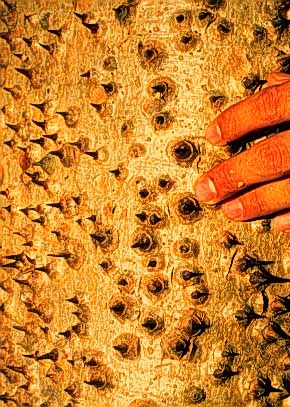
Hura crepitans L.
(Euphorbiaceae)
|
Hura crepitans L. (Euphorbiaceae) | |
Masís, A., Espinoza, R., Chavarría, F., Guadamuz, A. and Perez, D. 1998. Hura crepitans (Euphorbiaceae) Species Page, June 23, 1998. Species Home Pages, Area de Conservación Guanacaste, Costa Rica. http://www.acguanacaste.ac.cr
Tree up to 25 m tall and DBH 1(2) m (Croat, 1978).
Trees 15-40 m tall have been reported in the Osa Peninsula (Quesada et al., 1997).
Flower:
Red, apetalous (without petals)
Fruit:
Capsules with explosive dehiscence (Quesada et al., 1997).
Leaves:
Simples opposite, cordate form, 10-20 cm long. With white milky substance.
|
Upper surface |
Under surface |
Bark and wood:
The bark has very characteristic spines, hard and conical.
Whole plant architecture:
Similar species:
It can be confused with Bombacopsis quinata (Bombacaceae) and Zanthoxylum setulosum (Rutaceae) because of the spines on the trunk. However, both species have larger spines than those of Hura crepitans.
Verification:
II.Geographic distribution:
International:
Costa Rica to Perú, introduced in California, Florida and the old world tropics (Croat, 1978).
In Costa Rica:
Wet forests of the Pacific and Atlantic watersheds (Quesada et al., 1997).
In the Area de Conservación Guanacaste:
In the habitats of the Lowland Evergreen Forests (before you get to Playa Naranjo), Lowland Semideciduous Forests, and in the Tropical Submontane Wet Forest.
Map of macro-habitats of the ACG
|
III. Natural History:
The seeds and the milky substance are poisonous to humans (Croat, 1978).
IV. How to find:
In the lower entrance to Playa Naranjo it is possible to locate various large adults. In the Pailas sector on the trail to Fumarolas. In the Cacao sector, at the entrance to Góngora.
Acknowledgements.
This project was carried out by the Area de Conservación Guanacaste/CR, with help from INBio/CR, ICBG from the Foggarty center, NIH/USA and NSF/USA.
Thanks to Kate Beattie and Alexandra Kern for helping with the image management and the translation of this species page.
Literature cited.
Croat, T.B. 1978. Flora of Barro Colorado Island. Standford University Press, Standford.
Quesada, J.F., Jiménez, Q., Zamora, N., Aguilar, R., Gonzalez, J. 1997. Arboles de la Península de Osa.
Instituto Nacional de Biodiversidad, Heredia.